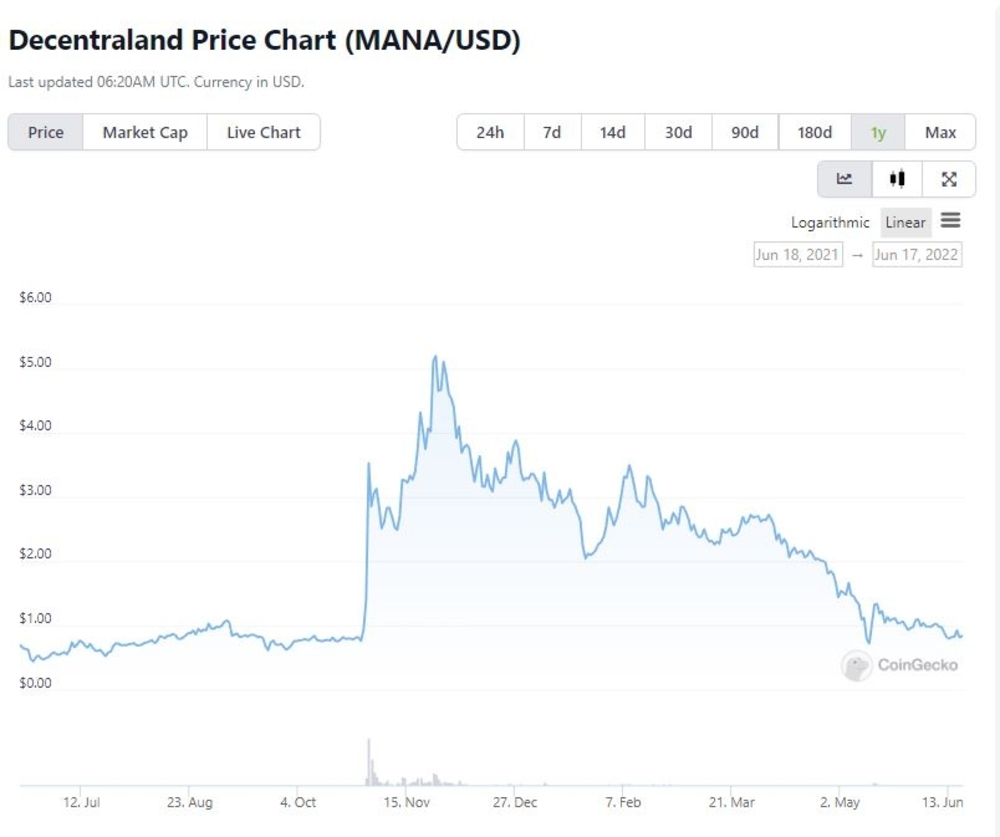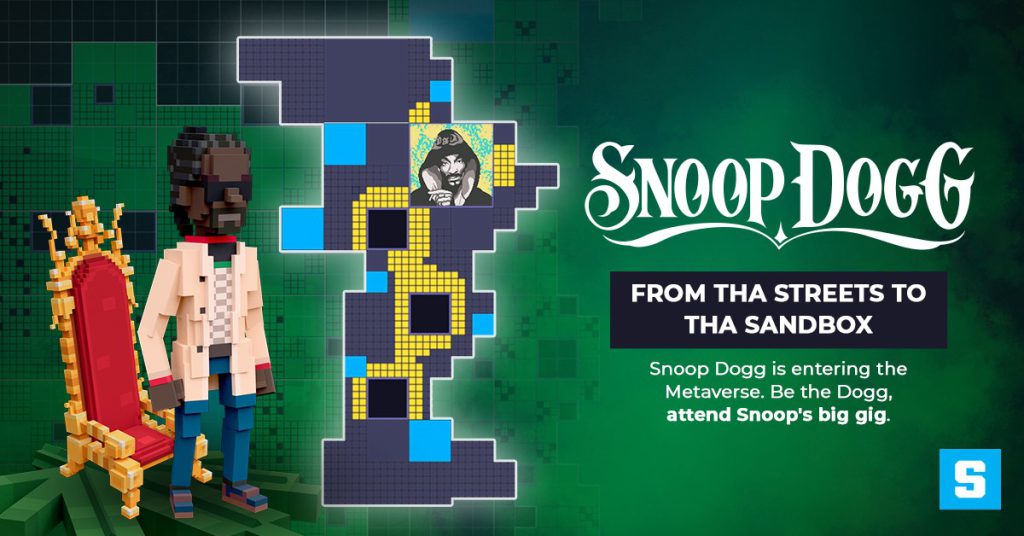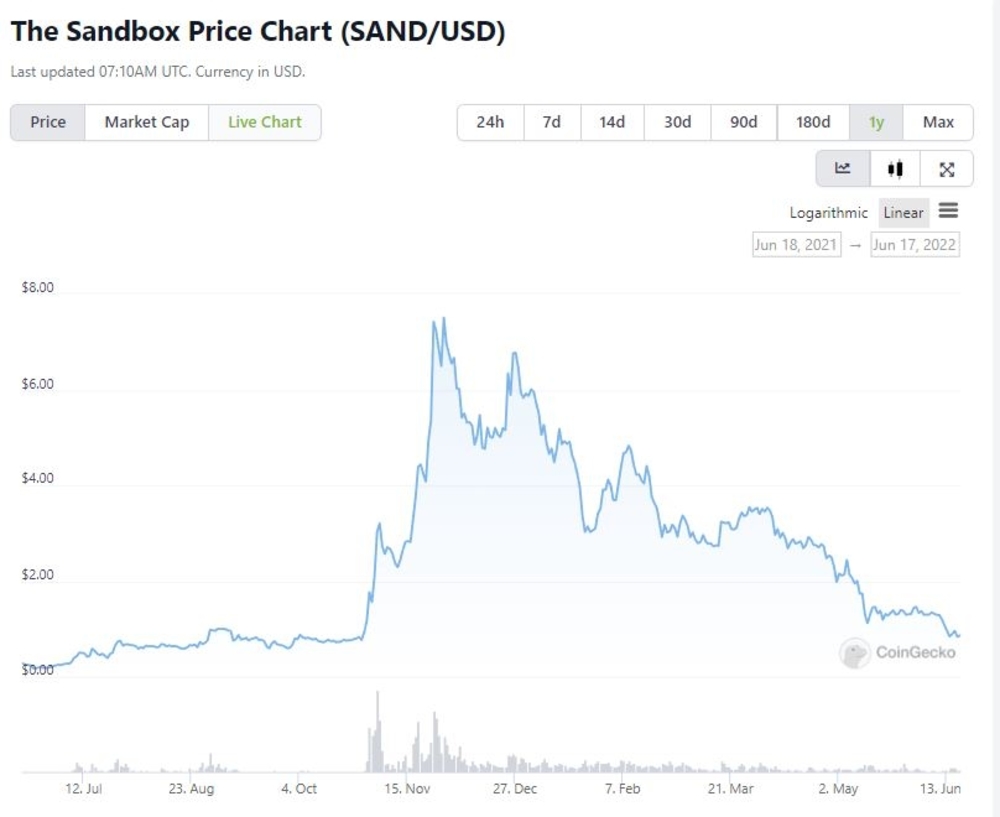The Metaverse, NFTs, and gaming used to be the hottest thing in town. With the upcoming NFT NYC event, the long term interest around this niche does not seem to be stopping.
Even the bear market has not stopped people from attempting to launch projects – some of which had its viral successes like Goblintown.
Also Read: A Crypto Scam Or Genius Marketing? Here’s How Goblintown Went Viral
I have previously discussed on the themes of NFTs and gaming, from the inevitable financialization of rare art NFTs to the problems plaguing GameFi.
Now, what about the old projects and the most popular projects of the past? Do they withstand the test of time today? Let’s take a look.
Also Read: Will The GameFi Bubble Explode? 3 Issues The Crypto Gaming Industry Have To Solve
Decentraland – Low on Mana
One of the most hyped up projects, Decentraland was one of the main representations of what Metaverse adoption could look like…
This is the same project that had an ATH of 7 billion USD in market cap at its peak hype.
Unfortunately, Decentraland’s active user count and metrics have fallen off a cliff. The daily user count for Decentraland, is only about 1000.
One of the attractions of Decentraland was also how users could acquire virtual lands in the Metaverse, using the $MANA token of course…
So let’s take a quick look at $MANA and the statistic of the virtual lands today.

Currently, MANA still trades at a 1 billion dollar valuation.

Other than the price floor of LAND falling, the number of units sold per month has also fallen by more than half since their peak month in 2021.

The Sandbox – Barren In Winter?
Once dubbed the “Minecraft” of blockchain, the Sandbox was even once marketed by Snoop Dogg, the legendary rapper.

So how did its attempt at the virtual world and Metaverse real estate work out?


The team has also attempted to raise 400 million of funds at a 4 billion dollar valuation in April.
On the flip side, institutions like Mastercard and their partnerships do promote adoption by providing a payments infrastructure for the NFT space
However, are they are a good reflection of prices and fundamental value today?
JUST IN: Mastercard has partnered with Immutable X, #Sandbox, Mintable, and others to allow NFT purchases without crypto.
— Watcher.Guru (@WatcherGuru) June 10, 2022
Is It Really Over? What Needs To Change?
I am excited for Web 3.0 and its future.
The idea of true ownership, a fairer system of ownership sounds appealing to me.
However, the Metaverse has various hurdles to clear, and like all crypto projects right now, most of them rely on tokenomics and incremental buyers to sustain the system of either virtual assets and the “coins” related to the project.
When the bear market sets in, these metrics of usage and price take a heavy plunge, and it is unclear if these projects will come back or deliver their roadmap.
In the long term, I think these are the things that might need to be considered for the Metaverse to be “successful”.
Should we replace human interaction?
One of the most common “FUD” on the Metaverse (which makes sense to me) is the criticism on how these projects, at its core, are escapist.
Going into a virtual reality and engaging in an experience there sounds fun, but it can also be a trap for people choosing to spend time in virtual reality as a substitute to what is happening in real life.
I think it is very interesting that some of the top comments on the video are averse to this new technology:
“This is by far the most inspiring thing ive ever seen…im inspired to throw away every electronic i own and run to live in the forest.”
“I’ll never understand this obsession of finding a new world for humans to escape to instead of just collectively working to fix the one we already have.“
Personally, I see some aspects of the Metaverse as a double edged sword.
Virtual classrooms and offices that are not limited to just Zoom currently are some examples on how the Metaverse can enhance the work/learning experience for people in the user.
These are all benefits that are good… in moderation. But when the lines between the Metaverse and the real world gets increasingly blurred, I know for sure which one I would rather pick.
The Metaverse needs to act as an enhancement for users, not market itself as a substitute.
Crimes in the Metaverse
Verbal assault, sexual harassment, online violence. What if these were done to YOUR virtual avatar? Would this be considered a crime?

As the Metaverse starts to approximate reality, perhaps these harmful actions that users might face in the Metaverse could be even more drastic than current cyber crimes.
I think activities like fraud, identity theft and attempts to steal your digital assets will also become more common place.
In today’s world, NFT holders laughably get phished all the time. As adoption of Metaverse projects rises, so too will there be more opportunities for a variety of exploits to happen.
What Does The Metaverse Really Mean?
I think the fact that this term is not really clearly defined hurts user adoption in the long run. Do participants and investors fully agree on definitions of the Metaverse?
Is the Metaverse just virtual reality? Is it NFTs? GameFi? A mix of all? What about the Web 3.0 ownership aspect? Creator opportunities?
I think as long as this term is still hazy, people don’t know exactly what they are getting into, and the pitch for users and developers become increasingly difficult.
And from what I know, when people don’t know what they are doing, things become very risky.
See Also: Nobody Is Too Big To Fail; The Fall Of Celsius And 3 Arrows Capital
Closing Thoughts
Capturing the attention of users and relying on heavy marketing is often the recipe to success – this has been observed in various projects in the space.
However, it is always good to take a look and re-evaluate your long term thesis, especially on organic metrics (user count, protocol revenue, sale of secondary assets).
Influencers, the public, and even famous celebrities were in on many of these projects (cited only popular examples).
Why do these projects and their actions become forgotten a few months later? What happened to the narratives?
I think it is important to ask yourself this: did you enter a space because of the vision in the Metaverse and Web 3.0, or were you just blinded by rising prices and crowd noise at that point in time? Where is the long term thesis?
Triple A title video game: $60 to play a fully finished game.
— DeFi Dude (dude.eth) (@defidude) May 3, 2022
Metaverse video game: $10000 for a character, you can play in 5 years when it’s built.
Something ain’t right here.
A massive reality check is needed on valuations of many projects in the space, as well as the reckless behavior that has blown up in the entire space’s faces recently.
And if you are a long term investor, the important question to ask is this – will my project and team I support survive and continue to build past the bear?
Also Read: The Mindset You Need: How S’pore Crypto Analysts Approach Projects Today
From small time retail players to large firms with massive assets under management, nobody is safe from hubris and fatal mistakes.
Furthermore, key questions and broader themes of the Metaverse remain quite controversial and should be food for thought. Is the Metaverse a future we really want?
So, does the Metaverse just a buzz word or is it something real (pun intended)? Are you being blinded by bearish or bullish bias right now? You decide.
Also Read: Things To Consider Before Putting In Your Next $1000 In Crypto (Beginner’s Edition)
[Editor’s Note: This article does not represent financial advice. Please do your own research before investing.]
Featured Image Credit: Chain Debrief



































